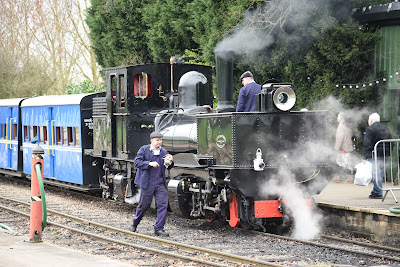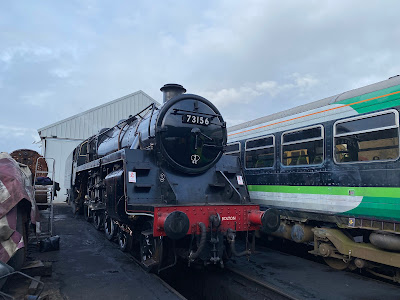"Late morning and K1 rests on the shed apron" (M.Waldron)
And just like that, there goes the first big Statfold event of the year: the spring Spectacle of Steam. This morning I was up early and out the door, on my way to Statfold's Tamworth base ready for a 06:30 book on. Of the eleven steam locomotives rostered to the 2ft railway for this event, I wasn't expecting my name to be once again penned to the pioneer Garratt K1, of 1909. This would be my second go on the big 0-4-4-0, having driven it a couple of years ago along with footplate chum Eddie the Late. Today I was joined by fireman Nigel (also an SBR driver) and third man/cleaner Isaac. Having signed in and double checked the increasing number of notices, I wandered out onto the apron where the Garratt was standing silent on the middle road. Hudswell Clarke "Fiji" was sitting quietly just behind us, under promising blue skies...
I clambered up into the cab of the big Garratt, remembering that the steps are not in line with the doorway (they'd foul the movement of the high pressure bogie if they were!). Opening the water gauges, I discovered 3/4 of a glass and the warmth emanating from the doorplate gave me some encouragement. All around us, the other ten engines out today were being prepared for lighting up. Nigel soon had a blaze on in the firebox, ably assisted by Isaac. A reassuring plume of grey smoke was soon lifting skyward towards the sunrise as I prepared to start with the oiling...
Oiling K1, compared to a Quarry or most other Statfold engines, is a bit like oiling up a Lizzie. There are four sets of individual Walschaerts valve gear, eight axleboxes and two mechanical lubricators. You know you've done it once you've gone around this thing...you might as well be on a big one! Nevertheless, with a multitude of oil cans and some old rag, I went around the two power bogies and put plenty of oil in plenty of places, starting with the driver's side of the high pressure engine...
Meanwhile, Nigel continued to build the fire whilst Isaac did some polishing of the paintwork. By now, with the other engines all turning onto coal, the atmosphere on shed was completed by the typical Statfold morning smog...
As I've already done a post on K1 that contained the engine's history, I thought I'd just do the old copy and paste for this part to save covering old ground. Here we go:
"As I said it was the pioneer Garratt locomotive, built by Beyer Peacock in 1909 (along with its sister K2) for the North East Dundas Tramway in Tasmania. Herbert William Garratt had patented his design in 1907, leading to the building of these engines. K1 and K2 hauled silver-lead ore trains in Tasmania until their withdrawal in 1929. The engines differed from later Garratts in that their cylinders faced inward towards the boiler rather than outward, as on later designs. K1 and K2 were also compound locomotives, with steam used first in the high pressure rear engine before being transferred via a long pipe beneath the boiler to be used in the low pressure front engine prior to exhaust. The success of this aspect of the design has been the subject of long running debate, though only one further compound Garratt was ever built after this first pair, perhaps suggesting the answer. Following retirement in Tasmania, Beyer Peacock purchased K1 back in 1947 and it became a museum exhibit before eventually being sold to the Ffestiniog Railway in 1966. Having spent time on display at the NRM in York, K1 was returned to steam in 2004.
Although the engine is almost too big for Statfold operations, she was deemed underpowered for the Welsh Highland Railway for which she was restored. Therefore, when her boiler ticket expired in 2014, she was placed into storage at Dinas. Following a move to Statfold for display in November 2019, the engine was assessed for overhaul and returned to steam in around 70 days following a re-tube and light repair".
There we are then: that was easy! Once I'd finished my oiling, I gave the motion and the fly cranks a good wipe down with some paraffin-oil mix, complementing Isaac's polishing efforts on the paintwork above. Following the usual 08:30 safety briefing on the lawn (we've been doing that since day dot), we devoured our bacon cobs before returning to our respective engines. The final job this morning was to perform a full vacuum brake test, not only because K1 is vac braked but also because we'd be pulling some vac stock today, in the form of the model Darj coaches. Once washed up and changed, we awaited the call to arms aboard the footplate of K1. Eventually, with a wave from the yard master, we were called down to the signalbox ready to take over the little blue carriages in platform two at around 10:30...
Once connected to the stock, we performed a continuity test with the two carriages, ensuring that they'd stop themselves should we split. With all well, we awaited the next 'up' train and, latterly, the road. After a steady run down to the balloon loop, during which the whistle chain came off in my hand (a good start), we awaited "Howard" with the next 'down' train as we attempted a temporary repair...
Hissing easily back to Oak Tree, we came to a stand in the platform and gave K1's tank a top up. We ourselves enjoyed some tea and cake from the volunteers' mess on the platform as we awaited our next path with our short train...
We ended up pulling the Darj coaches for four of our five trips today, chiefly because there were only three vacuum braked engines out: us, "Fiji" and "Harrogate". Once back at Statfold, we were shunt released via the signalbox before being put on shed briefly. Once the Darj coaches had completed another trip, we were called down again to take them over. Below, K1 blows up the train whilst awaiting the road...
Max (who has kindly provided two of the images used in this post) joined us on the footplate for the second trip. Max is a regular at Statfold enthusiast's events and we always end up having a chat. (His Flickr account can be found here). For our third trip we managed to get a quick run out on the high level. Recent changes at Statfold have meant that the old high level platform (platform three) is now out of gauge for most traffic and so high level trains use the low level platforms via the crossover. A call to the signalbox (and a few kind words) saw us put on the next departing high level train and so we went for a quick spin down the locally known 'concrete road'. It was nice to get K1's big wheels spinning a bit faster for a change. As we were the only ones on the high line (and we had priority at the balloon loop), we whizzed around and were soon waiting at Statfold's S2 signal for a platform. I grabbed this rushed shot as I walked back to the engine, having just phoned in from S2's signal post telephone...
Once back in Statfold's platform two, we were shunt released again by the next departing locomotive. It was only a few minutes before we were called to takeover the adjacent train in platform one as Peckett "Harrogate" was struggling to maintain vacuum on the Darj coaches. Therefore, K1 (with a larger ejector too) was drafted in to takeover. Max caught us at Oak Tree with our fourth round trip...
"God only knows what I'm doing" (M.Waldron)
The fourth trip was followed by a short period on shed, during which we kind of hoped that we'd been retired for the day, with the clock having ticked past 16:00. However, following a final wave from the yard master, we were called out one last time to take the Darj coaches again, departing Statfold as the last passenger train at around 16:40. At Oak Tree, with the train having terminated and passengers having alighted, the Garratt was uncoupled from the stock and drawn forward to meet token carrier "Fiji". The two engines then ran back up to Statfold together, with K1 hissing along behind the Hudswell. Once back on shed on the middle road, we disposed of the K1 after a long but pleasant day out. We were just in time to miss the rain...
I must thank Nigel and Isaac for their help and company today aboard K1: cheers lads. Thanks also to Max for letting me use two of the pictures from your outing today. Well folks, that's two goes on K1 safely completed. I must admit, although last time was a novelty as it was the first time out for me with this locomotive, this time I felt more in control with it. The brake adjustments that were completed since my last go have also helped it massively, with the engine's own steam brake being far more effective than the last time I drove it. (It was likened to a handbrake on a canoe last time!). Overall, another pleasant outing with the pioneer Garratt. Thanks to all who made this weekend's event happen and thanks to whoever reads this muck. Ciao...
























































